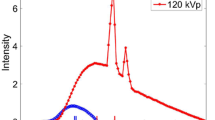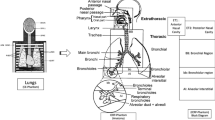Abstract
Magnetic resonance imaging (MRI) is considered a safe technology since it relies only on spatial encoding of the position of atomic nuclei (mainly protons) in a static magnetic field irradiating them with radio-frequency (RF) pulses instead of ionizing radiation. Specific absorption rate (SAR) is the most frequently used parameter for monitoring and quantifying the power deposition on a subject during an MRI examination. The peak-to-average SAR ratio is important information for the MRI operator during the acquisition sequence setup. In this work, a birdcage body coil model is used for RF excitation of several inhomogeneous human thorax models with different sizes and weights. To study the peak-to-average SAR ratio correlation with sample metrics, numerical simulations using the finite difference time domain method were performed to estimate the peak and average SAR values on the entire sample volume. Results for 11 different thorax models indicate a strong correlation between the peak-to-average SAR value and the sample metrics.





Similar content being viewed by others
References
D. Formica, S. Silvestri, BioMed. Eng. OnLine, 3–11 (2004)
V. Hartwig, G. Giovannetti, N. Vanello, M. Lombardi, L. Landini, S. Simi, Int. J. Environ. Res. Pub. Health 6, 1778–1798 (2009)
D.E. McRobbie, E.A. Moore, M.J. Graves, M.R. Prince, MRI—From Picture to Proton (Cambridge University Press, Cambridge, 2006)
F.M. Vogt, M.E. Ladd, P. Hunold, S. Mateiescu, F.X. Hebrank, A. Zhang, J.F. Debatin, S.C. Göhde, Radiology 233, 548–554 (2004)
D.J. Schaefer, J.D. Bourland, J.A. Nyenhuis, J. Magn. Reson. Imaging 12, 20–29 (2000)
F. Krasin, H. Wagner, in Encyclopedia of Medical Devices and Instrumentation, ed. by J.G. Webster (Wiley, Hoboken, 1988)
C. Polk, in Handbook of Biomedical Engineering, ed. by J. Bronzino (CRC Press, USA, 1995)
F.G. Shellock, J. Magn. Reson. Imaging 12, 30–36 (2000)
M.A. Ali, Romanian J. Biophys. 17(4), 277–286 (2007)
S. Simi, M. Ballardin, M. Casella, D. De Marchi, V. Hartwig, G. Giovannetti, N. Vanello, S. Gabbriellini, L. Landini, M. Lombardi, Mutat. Res. 645, 39–43 (2008)
D.I. Hoult, J. Magn. Reson. Imaging 12, 46–67 (2000)
International Electrotechnical Commission: International standard: Part 2. Particular requirements for the safety of magnetic resonance equipment for medical diagnosis. CEI/IEC 60601-2-33 (2002)
Z. Wang, J.C. Lin, W. Mao, W. Liu, M.B. Smith, C.M. Collins, J. Magn. Reson. Imaging 26, 437–441 (2007)
IEEE recommended practice for measurements and computations of radio frequency electromagnetic fields with respect to human exposure to such fields, 100 kHz–300 GHz. IEEE Std C95.3-2002 (Revision of IEEE Std C95.3-1991), pp. i–126 (2002). doi:10.1109/IEEESTD.2002.94226
P.A. Bottomley, R.W. Redington, W.A. Edelstein, J.F. Schenck, Magn. Reson. Med. 2, 336–349 (1985)
W. Liu, C.M. Collins, M.B. Smith, Appl. Magn. Reson. 29, 5–18 (2005)
H. Cline, R. Mallozzi, Z. Li, G. McKinnon, W. Barber, Magn. Reson. Med. 51, 1129–1137 (2004)
G. Brix, M. Reinl, G. Brinker, Magn. Reson. Imaging 19, 769–779 (2001)
J.W. Hand, Phys. Med. Biol. 53, R243–R286 (2008)
O.P. Gandhi, X.B. Chen, Magn. Reson. Med. 41, 816–823 (1999)
K.S. Yee, IEEE Trans. Ant. Propag. 14, 302–307 (1966)
C.M. Collins, M.B. Smith, Magn. Reson. Med. 45, 684–691 (2001)
ICNIRP Statement, Health Phys. 87(2), 197–216
K.S. Kunz, R.J. Luebbers, The finite difference time domain method for electromagnetics (CRC, Ann Arbor, 1993)
GEMS, Computer and Communication Unlimited, PA, USA (2008). http://www.2comu.com
GID, International Center for Numerical Methods in Engineering, Barcelona, Spain (2009). http://gid.cimne.upc.es/index.html (accessed 14 December 2009)
Acknowledgments
We wish to thank Prof. P.A. Bottomley for his expert advice and Dr. D. Yeo for his helpful discussions.
Author information
Authors and Affiliations
Corresponding author
Rights and permissions
About this article
Cite this article
Hartwig, V., Giovannetti, G., Vanello, N. et al. Numerical Calculation of Peak-to-Average Specific Absorption Rate on Different Human Thorax Models for Magnetic Resonance Safety Considerations. Appl Magn Reson 38, 337–348 (2010). https://doi.org/10.1007/s00723-010-0126-z
Received:
Published:
Issue Date:
DOI: https://doi.org/10.1007/s00723-010-0126-z




